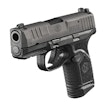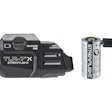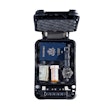Today, cops are facing some of the most challenging circumstances in law enforcement history. First-responders are engaging heavily armed bank robbers and racing to active-shooters in public places such as schools and even day care centers. All are critical incidents requiring the best we have to offer - to say the least.
However, if you examine past performances in crisis situations, you'll find that the "life and death" scenarios are not the ones officers have the greatest difficulty resolving. Suspects creating imminent danger of death or serious injury must be stopped-in the surest and most expeditious fashion. Few officers have difficulty recognizing this and they take swift and sure action. Unfortunately, things become more complicated when officers face potentially deadly situations, such as those involving armed, non-assaultive and non-compliant subjects.
Mentally deranged and/or suicidal subjects create special handling problems for police officers. They are especially problematic in cases where their actions are not overtly aggressive, but clearly demand police intervention to prevent further escalation. For example, officers dispatched to a domestic situation find a young girl armed with an eight inch knife. She's sitting in her room and ignores repeated requests to put down the weapon. What should they do if she tries to leave or turns the weapon on herself?
Less-Lethal Force Options
Today, in cases where death or serious injury would not be appropriate, officers use a variety of tools designed to incapacitate. OC (pepper) spray has become standard issue but can only be used in dangerously close proximity to the suspect. Impact projectiles such as "bean bags" and "plastic bullets" have stopped hundreds of suspects nationwide -- all at much longer and safer distances. Unfortunately, as with any impact instrument, these projectiles always injure to some degree.
These are "pain compliance" devices that use physical discomfort to coerce or force a suspect into stopping deviant behavior. But what should an officer do with a person who:
l. Is potentially too dangerous to approach, yet not engaged in behavior that justifies the risk of impact projectile injury?
2. Is showing an obvious sign of "mind-body separation" such as self-mutilation, which clearly demonstrates that pain compliance techniques would likely be ineffective?
M26 Advanced TASER
The name is familiar to veteran officers, and the TASER is once again a "hot topic" in resistance control circles. The newest version of this 35-year-old technology is the M26 Advanced TASER and it offers a number of improvements over earlier devices, including:
Twenty one-foot maximum effective range.
26 watts versus 7 watts of stopping power.
Handling and deployment characteristics similar to a semi-automatic pistol.
Battery status "ready" light.
Trigger does not have to be continuously held back to transmit the energy.
Data port tracks use history.
The M26 is a black plastic "conducted energy weapon" that looks like a semi-automatic pistol. Depending on your perspective, this could be good or bad.
The weapon is loaded by taking a live cartridge in one hand and the M26 in the other. Ensure the safety is down and point the weapon in a safe direction. Squeeze the release buttons on each side of the cartridge with thumb and index finger and place it firmly into the open, muzzle end. The cartridge cannot be put in upside down or backwards.
The weapon can be carried in a variety of ways, with the most common and practical methods utilizing the two holsters available from the manufacturer. One is a black nylon "leg drop" that attaches in seconds to the weak side of an officers duty belt. The second is a conventional belt mount, which requires the officer to wear the M26 during the entire shift. This clearly ensures ready availability should a spontaneous event occur. Likewise, a gun on each hip will generate more than a casual glance from the citizens you meet on the street!
Deploying
Moving the safety into the "up" position arms the weapon. Immediately, a red laser dot is projected from the front and a flashing red "battery indicator" is visible at the rear. The laser dot is placed on the intended target and the trigger/switch is pulled. Two small probes are propelled at 175 feet per second at distances up to 15 or 21 feet (depending on the cartridge) by non-pyrotechnic compressed nitrogen. The top probe is designed to strike within an inch of the laser dot. The bottom probe is designed to strike directly below at an 8-degree trajectory. This causes a spread of roughly one-foot for every seven feet of travel.
The probes are connected to the weapon by high-voltage insulated wire. When contact occurs, electrical pulses are transmitted into the suspect's body. The probes are able to deliver their electrical charge through two inches of clothing. The transmission continues for five seconds regardless of the trigger position, unless stopped by the operator moving the safety into the "down" position.
According to the manufacturer's literature, when the current is applied it "interferes with and overrides the body's neuromuscular system and voluntary muscle control is lost between the two dart points. As a result of this current being delivered into a subject, they will usually fall to a grounded position or freeze in place." Interesting.
Testing
The M26 was then put through a series of tests. The operator's manual was followed verbatim and the M26 performed from a function-perspective as intended. It fit in the holsters well and the units were readily accessible. The cartridges loaded and unloaded easily and test firing occurred at ranges up to 21 feet. The top probe contacted the target at or near the laser dot and the lower probe spread consistent with the printed literature.
This was followed by a practical test involving twenty-three volunteers. Many were veterans of earlier seven-watt TASER tests and all had been subjected to direct OC exposure. Mats were placed on the floor and "spotters" positioned beside each person. Probes were attached and the participants were given foam batons. They were then asked to focus all of their attention on the TASER operator and attempt to attack him. All twenty-three officers were fully and immediately incapacitated by the M26. Twenty-one experienced a dynamic response including a high-speed movement off their feet.
Tests such as this are interesting but officers should be cautioned against taking the dramatic results and assuming such outcomes are guaranteed on the street. Several thousand controlled OC exposures strongly suggest that officers who participate in such tests generally:
Have a low tolerance for pain -- unlike many suspects.
Lack true motivation to focus and fight through the effects -- unlike many suspects.
Are very susceptible to the psychological processes created by apprehension and the subconscious modeling of behavior that often occurs in such group environments.
The Cat's Meow?
This is not a perfect tool. The electrical impulse has ignited alcohol based OC sprays that were on suspects prior to deployment and in one case several years ago a probe was embedded in a suspect,s eye.
However, based on several thousand U.S. and Canadian field tests and over 200 documented street encounters, the M26 Advanced TASER appears to offer a less lethal incapacitation capability that has simply not been available before. When an agency is seeking a balance between the need to incapacitate and the acceptability of the potential injury outcome, I'm not sure anything else in law enforcement can compare to this kind of technology.












